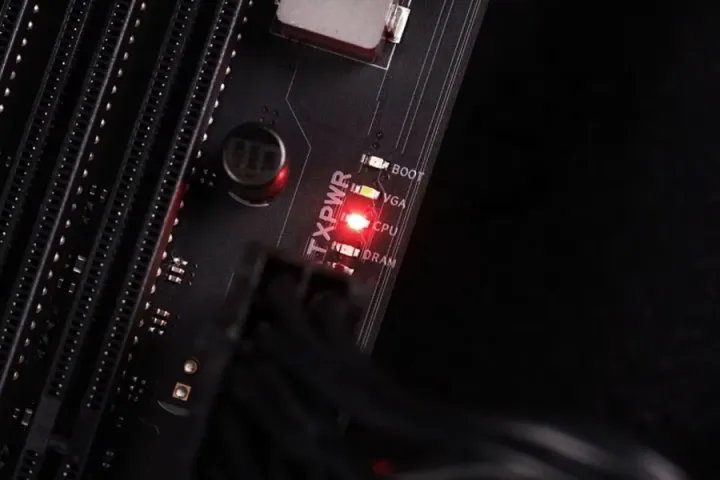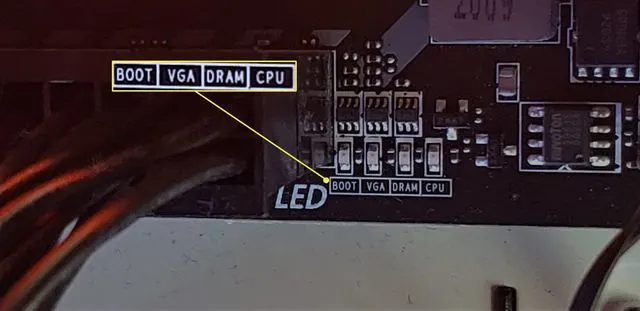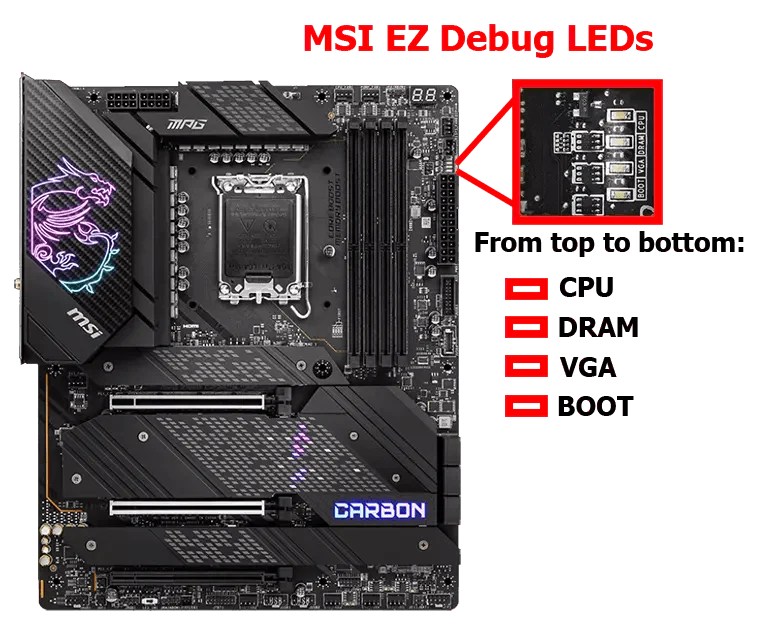
Red Light on Motherboard Explained: Causes, Meaning, and How to Fix It
A red light on your motherboard could indicate a malfunctioning critical piece of hardware or it could be as harmless as some flashy RGB lighting. It is time to investigate if you have a red LED light on the motherboard and your computer is giving you difficulties or just won’t power on at all. This blog will show how to find out what it means, what usually causes it, and how to fix motherboard light red with the CPU, RAM, or power.
What does a red cpu light mean on a motherboard

A red light on motherboard of your computer usually indicates that one of the internal parts of your computer isn’t functioning properly. The POST (Power On Self-Test) sequence, which occurs when you turn on the computer, is the most frequent moment for this red light to show.
The motherboard of your computer houses the BIOS (Basic In-Out System), which is the base-level software that manages the fundamental startup and operation of its parts. When your computer turns on, the BIOS performs a set of checks called the POST. If any of your components aren’t working properly, your BIOS will alert you during the POST procedure. How does it inform you, too? Why, of course, by means of a red light on your motherboard.
How to Read a Red Light on a Motherboard
The red light will be next to each label on the four primary indicators found on more recent boards. They are:

BOOT Red Light : A red light next to the BOOT indicator means that there is a problem with the boot devices, especially the hard disk that houses the operating system.
VGA Red Light : If there is a red light next to the VGA or GPU indication, the graphics card is either not seated correctly or is not detected.
DRAM Red Light : If the RAM module isn’t installed correctly, a red light will appear close to the DRAM indication. An unfastened clamp on each side of a RAM stick may be the reason.
CPU Red Light : If this indicator is red, it means the motherboard is not recognizing the CPU.A dead CMOS battery, broken pins, an unplugged CPU fan, or an incorrectly connected CPU are some potential causes of the red light.
A single red LED on the majority of motherboards indicates a hardware defect, but it doesn’t provide any details about the issue. To assist with system faults, some older motherboards are equipped with a speaker. In the event that your motherboard includes a speaker, ensure sure it is connected because the motherboard can play tones to identify the issue. The manual that came with your motherboard will tell you which tone is associated with which issue.
How to fix cpu red light on motherboard
There are several things you might attempt if you think the motherboard’s red light is due to a CPU error:
Reinstall the CPU: Take out the processor and its cooler, then put it back in. See our PC building guide for more thorough instructions.
Verify that the cooler is securely fastened and that the CPU fan is spinning up correctly. The motherboard can be receiving a warning not to start up from a loose or malfunctioning cooling.
Update the BIOS firmware: It’s possible that the motherboard doesn’t support the newer CPU you just installed on an older motherboard. Still. Before reinstalling the newer processor, install an older CPU that you are certain is functional and update the BIOS. If in doubt, confirm that the CPU is officially supported by consulting the motherboard’s compatibility list as well.
Test the CPU: To ensure that the processor is operating properly, try testing it in a different computer if at all possible.
Additional items to verify
Unplug everything: Unplugging everything unnecessary is a common troubleshooting technique. See if it resolves the issue. Remove all but one RAM stick, all storage drives, any unnecessary add-in cards, and unplug all USB devices except your keyboard and mouse.
Recreate the memory: Try taking out both sticks and reinstalling them if you believe it might be the RAM. Try using only one stick. Use the opposite stick to try.
Verify that there is power in everything. Have you plugged in the power wires for the graphics card? What about the motherboard’s top CPU power cable? Verify that everything you need to plug in has been done correctly. Unplug and re-plug them if you’re unsure.
You may need to think about upgrading hardware if you’ve tried every one of the aforementioned fixes and the red light on your PC motherboard persists. However, try a few of these quick-fix suggestions first.
How to Identify and Troubleshoot Debug cpu Light motherboard

Finding and Taking in the Lights
Locate the debug lights. They are typically positioned close to the CPU socket or the motherboard’s edge (see example depicted).
If you are unable to find the lights, we advise you to consult the handbook for your motherboard.
Turn on your computer and check the debug lights. Where the boot process is failing can be inferred from the order in which they illuminate. Make a note if the
Check out the Indicators
To determine the precise problem that each light signifies, consult the signs listed above. Additional model-specific information may be found in your motherboard handbook.
Follow the appropriate troubleshooting procedures based on which light blinks or remains lighted. Reseating parts, verifying power connections, updating the BIOS, or swapping out malfunctioning hardware could all be part of this process.
FAQ
Why is my cpu light on my motherboard?
Your motherboard’s CPU debug LED will light up if the CPU is poorly installed, the CMOS battery is dead, or the CPU power connections are incorrect. A damaged CPU, incompatible hardware, CPU cooling difficulties, or BIOS issue are some possibilities. Look for bent pins, check the CPU installation, power cords, and motherboard BIOS compatibility to find the problem.
What does a red flashing light mean on an AMD motherboard?
A CPU recognition mistake, accumulated debris, or a visual card problem could all generate a red blinking light. Check which indicator is illuminated if it is labeled, then follow the previous instructions. If the explanation of the solid or flickering light patterns is not included in the documentation, refer to the user manual or customer service.
How to fix red cpu light on motherboard?
If a motherboard’s CPU light is red, reset the CMOS using a jumper or remove the battery, then reseat the CPU and RAM to ensure good connection and dust-free operation. Verify that the CPU power wires are securely attached to the motherboard and that the CPU cooler works properly. If the problem persists, you may have a bad CPU, CPU socket, or power supply.
Can a faulty power supply trigger a red cpu light?
Although rare, a red CPU light may be caused by a malfunctioning (or incorrectly connected) PSU.
Make sure the switch on the back of the PSU is turned to “On” and that the PSU connector is hooked into the motherboard correctly. Connecting your PSU to another functional motherboard is another way to test it.
Can overclocking cause a red cpu light?
Yes, a red CPU light can be caused by improperly configured overclocking. To return the settings to their original state, you will need to reset the BIOS.











